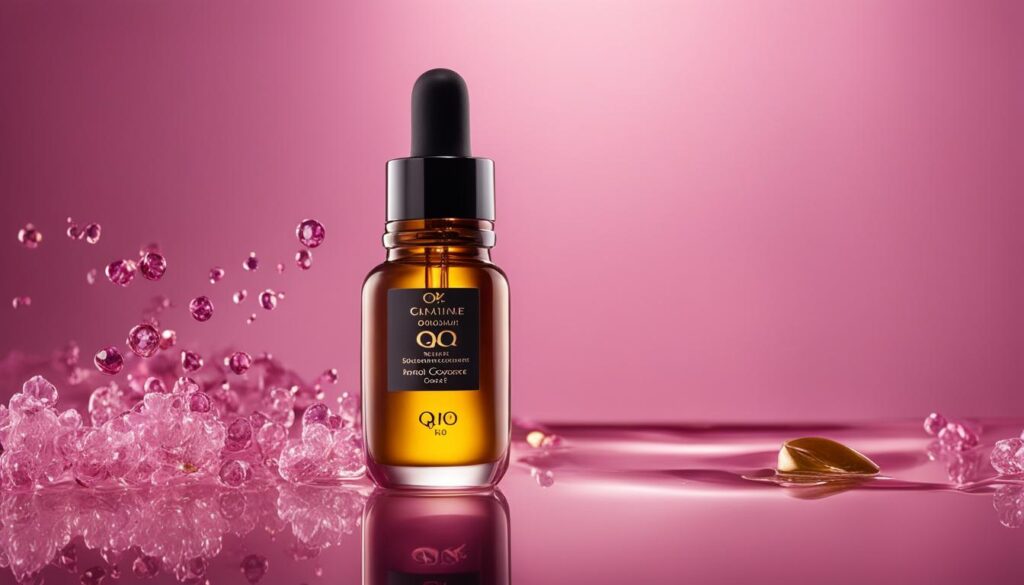Coenzyme Q10, also known as CoQ10, is a naturally occurring antioxidant that promotes skin rejuvenation and helps protect skin cells from damage. Making your own Coenzyme Q10 products at home is a cost-effective and rewarding process. By following a few simple steps, you can produce homemade Coenzyme Q10 facial oil or serum using readily available ingredients and materials.
Whether you want to save money or have full control over the ingredients, creating your own Coenzyme Q10 products allows you to tailor them to your specific needs and preferences. From production and synthesis to extraction and manufacturing, this DIY guide will walk you through the complete process of making Coenzyme Q10 at home.
Key Takeaways:
- Coenzyme Q10 is a natural antioxidant that promotes skin rejuvenation and protects skin cells.
- Creating your own Coenzyme Q10 products at home is cost-effective and allows customization.
- The DIY process includes production, synthesis, extraction, and manufacturing of Coenzyme Q10.
- By following this guide, you can learn how to make homemade Coenzyme Q10 facial oil or serum.
- Experiment with different carrier oils, beneficial oils, and extracts to personalize your DIY recipe.
Ingredients and Equipment for Making Coenzyme Q10 Facial Oil
To make Coenzyme Q10 facial oil, you will need the following ingredients:
- Coenzyme Q10 powder: This can be obtained from capsules available online or at health stores. You will need around 30-60 mg of CoQ10 powder per ounce of carrier oil.
- Carrier oil: Choose a carrier oil that suits your skin type, such as jojoba oil, sweet almond oil, or grapeseed oil.
- Optional beneficial oils or extracts: You can enhance your facial oil with additional oils or extracts like vitamin E oil, rosehip oil, or lavender essential oil.
You will also need the following equipment:
- Small whisk or sanitized dropper for mixing the ingredients
- Clean, dark glass container with a dropper or pump for storing the facial oil
- Label for labeling the container with the ingredients and date

Step-by-Step Guide for Making Coenzyme Q10 Facial Oil
Follow these steps to make your own Coenzyme Q10 facial oil:
- Choose a carrier oil: Select a carrier oil based on your skin type and preferences.
- Measure carrier oil: Determine the desired amount of carrier oil based on your container size. A 1-ounce (30 ml) dropper bottle is commonly used for facial oils.
- Prepare CoQ10 powder: If using CoQ10 capsules, carefully open the capsules and pour the powder into a clean container. Use approximately 30-60 mg of CoQ10 powder per ounce of carrier oil.
- Mix CoQ10 with carrier oil: Gradually add the CoQ10 powder to the carrier oil while stirring slowly to ensure even distribution. Use a small whisk or sanitized dropper to mix the ingredients.
- Add optional oils or extracts: Incorporate additional beneficial oils or extracts, such as a few drops of vitamin E oil, rosehip oil, or essential oils, into the mixture.
- Transfer to a container: Carefully transfer the oil mixture to a clean, dark glass container with a dropper or pump. A dark-colored bottle helps protect the CoQ10 and other ingredients from degradation caused by light exposure.
- Label and store: Clearly label the container with the ingredients and date, and store it in a cool, dark place to preserve its potency. Use the facial oil within 6 months for optimal freshness and effectiveness.

Tips and Considerations for Using Coenzyme Q10 Facial Oil
When incorporating Coenzyme Q10 facial oil into your skincare routine, it’s important to follow these tips and considerations for optimal usage:
- Apply a few drops of Coenzyme Q10 facial oil to clean, damp skin.
- Gently massage the oil into your skin using your fingertips.
- Use the facial oil in the morning or evening, or as needed.
- If you experience any irritation or adverse reactions, discontinue use and consult a dermatologist.
- Store the facial oil in a cool, dark place to prolong its shelf life and maintain its potency.
- Use within 6 months of preparation for optimal freshness and effectiveness.
- Consider conducting a patch test before applying the facial oil to your face to check for any allergic reactions or sensitivities.
“Proper application and storage of CoQ10 facial oil can help maximize its benefits and ensure a positive experience for your skin.”
By following these tips and considering the guidelines, you can reap the full benefits of Coenzyme Q10 oil and achieve healthier, rejuvenated skin.
Why is Proper Application Essential?
The application of Coenzyme Q10 facial oil is vital to ensure that the active ingredients effectively penetrate the skin and deliver their beneficial properties. By applying a few drops to clean, damp skin, you allow the oil to be easily absorbed and integrated into your skincare routine.
Storage and Freshness
Storing your Coenzyme Q10 facial oil in a cool, dark place is crucial to maintain its potency and extend its shelf life. Light and heat can degrade the oil and compromise its effectiveness. Additionally, using the facial oil within 6 months of preparation ensures optimal freshness and potency of the CoQ10 and other beneficial ingredients.

Benefits and Alternatives of Coenzyme Q10 Facial Oil
Coenzyme Q10 facial oil offers a range of benefits for your skin. With its antioxidant properties, it helps protect your skin from free radicals that can cause premature aging and damage. Regular use of CoQ10 oil can also aid in skin rejuvenation by promoting collagen production, which helps to maintain your skin’s elasticity and firmness. Additionally, Coenzyme Q10 facial oil helps retain moisture, keeping your skin hydrated and nourished.
If you prefer alternatives to Coenzyme Q10, there are other effective options available. One alternative is vitamin E (tocopherol acetate), which is a powerful antioxidant that offers similar benefits for your skin. Vitamin E can be used as a substitute in facial oil formulations, providing protection against free radicals and helping to maintain healthy skin. Experimenting with different carrier oils and beneficial oils or extracts can further personalize your DIY facial oil recipe, allowing you to tailor it to your unique skin needs and preferences.
When incorporating Coenzyme Q10 facial oil or its alternatives into your skincare routine, remember to follow proper application techniques. Apply a few drops of facial oil to clean, damp skin and gently massage it in with your fingertips. You can use the oil in the morning or evening, as part of your regular skincare routine. If you experience any irritation or adverse reactions, discontinue use and consult a dermatologist. Store your facial oil in a cool, dark place to ensure its freshness and effectiveness, and use it within six months for optimal results.
FAQ
Can I make Coenzyme Q10 facial oil at home?
Yes, making your own homemade Coenzyme Q10 facial oil is a cost-effective and rewarding process.
What ingredients do I need to make Coenzyme Q10 facial oil?
To make Coenzyme Q10 facial oil, you will need Coenzyme Q10 powder, a carrier oil, optional beneficial oils or extracts, a small whisk or sanitized dropper for mixing, a clean, dark glass container with a dropper or pump for storing, and labels for labeling.
How do I make Coenzyme Q10 facial oil?
Follow these steps to make DIY Coenzyme Q10 facial oil: (1) Choose a carrier oil, (2) Measure carrier oil, (3) Prepare Coenzyme Q10 powder, (4) Mix Coenzyme Q10 with carrier oil, (5) Add optional oils or extracts, (6) Transfer to a container, (7) Label and store.
How should I use Coenzyme Q10 facial oil?
Apply a few drops of Coenzyme Q10 facial oil to clean, damp skin and gently massage it in with your fingertips. You can use it in the morning or evening, or as needed.
What are the benefits of using Coenzyme Q10 facial oil?
Coenzyme Q10 facial oil offers several benefits, including antioxidant protection, skin rejuvenation, and moisture retention. Regular use of CoQ10 oil can help prevent collagen breakdown, repair UV damage, and increase skin cell turnover.
Are there alternatives to Coenzyme Q10 for facial oil?
Yes, other strong antioxidants like vitamin E (tocopherol acetate) can be used as substitutes in facial oil formulations. Additionally, you can experiment with different carrier oils and additional beneficial oils or extracts to personalize your DIY facial oil recipe.






